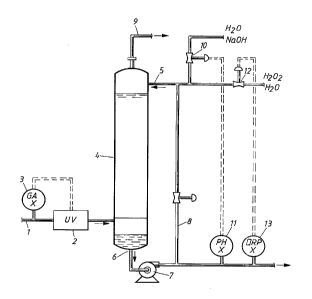Some of the information on this Web page has been provided by external sources. The Government of Canada is not responsible for the accuracy, reliability or currency of the information supplied by external sources. Users wishing to rely upon this information should consult directly with the source of the information. Content provided by external sources is not subject to official languages, privacy and accessibility requirements.
Any discrepancies in the text and image of the Claims and Abstract are due to differing posting times. Text of the Claims and Abstract are posted:
| (12) Patent: | (11) CA 2219058 |
|---|---|
| (54) English Title: | METHOD OF TREATING CHLORINE DIOXIDE |
| (54) French Title: | METHODE POUR TRAITER LE DIOXYDE DE CHLORE |
| Status: | Expired |
| (51) International Patent Classification (IPC): |
|
|---|---|
| (72) Inventors : |
|
| (73) Owners : |
|
| (71) Applicants : |
|
| (74) Agent: | NORTON ROSE FULBRIGHT CANADA LLP/S.E.N.C.R.L., S.R.L. |
| (74) Associate agent: | |
| (45) Issued: | 2000-07-18 |
| (22) Filed Date: | 1997-10-24 |
| (41) Open to Public Inspection: | 1998-04-30 |
| Examination requested: | 1997-10-24 |
| Availability of licence: | N/A |
| (25) Language of filing: | English |
| Patent Cooperation Treaty (PCT): | No |
|---|
| (30) Application Priority Data: | ||||||
|---|---|---|---|---|---|---|
|
The invention relates to a method of destructing chlorine dioxide comprising thesteps of:
(a) irradiating the chlorine dioxide to effect conversion of chlorine dioxide to chlorine; and
(b) reacting at least part of the chlorine from step (a) to substantially yield chloride.
L'invention porte sur une méthode pour détruire le dioxyde de chlore, consistant à : a) irradier le dioxyde de chlore pour effectuer la conversion du dioxyde de chlore en chlore; b) faire réagir au moins une partie du chlore de l'étape a) pour obtenir un bon rendement en chlore.
Note: Claims are shown in the official language in which they were submitted.
Note: Descriptions are shown in the official language in which they were submitted.

For a clearer understanding of the status of the application/patent presented on this page, the site Disclaimer , as well as the definitions for Patent , Administrative Status , Maintenance Fee and Payment History should be consulted.
| Title | Date |
|---|---|
| Forecasted Issue Date | 2000-07-18 |
| (22) Filed | 1997-10-24 |
| Examination Requested | 1997-10-24 |
| (41) Open to Public Inspection | 1998-04-30 |
| (45) Issued | 2000-07-18 |
| Expired | 2017-10-24 |
There is no abandonment history.
| Fee Type | Anniversary Year | Due Date | Amount Paid | Paid Date |
|---|---|---|---|---|
| Request for Examination | $400.00 | 1997-10-24 | ||
| Registration of a document - section 124 | $100.00 | 1997-10-24 | ||
| Application Fee | $300.00 | 1997-10-24 | ||
| Maintenance Fee - Application - New Act | 2 | 1999-10-25 | $100.00 | 1999-09-27 |
| Final Fee | $300.00 | 2000-04-14 | ||
| Maintenance Fee - Patent - New Act | 3 | 2000-10-24 | $100.00 | 2000-09-29 |
| Maintenance Fee - Patent - New Act | 4 | 2001-10-24 | $100.00 | 2001-09-18 |
| Maintenance Fee - Patent - New Act | 5 | 2002-10-24 | $150.00 | 2002-09-19 |
| Maintenance Fee - Patent - New Act | 6 | 2003-10-24 | $150.00 | 2003-09-17 |
| Maintenance Fee - Patent - New Act | 7 | 2004-10-25 | $200.00 | 2004-10-04 |
| Maintenance Fee - Patent - New Act | 8 | 2005-10-24 | $200.00 | 2005-10-04 |
| Maintenance Fee - Patent - New Act | 9 | 2006-10-24 | $200.00 | 2006-10-02 |
| Maintenance Fee - Patent - New Act | 10 | 2007-10-24 | $250.00 | 2007-10-01 |
| Maintenance Fee - Patent - New Act | 11 | 2008-10-24 | $250.00 | 2008-09-30 |
| Maintenance Fee - Patent - New Act | 12 | 2009-10-26 | $250.00 | 2009-10-01 |
| Maintenance Fee - Patent - New Act | 13 | 2010-10-25 | $250.00 | 2010-09-30 |
| Maintenance Fee - Patent - New Act | 14 | 2011-10-24 | $250.00 | 2011-09-30 |
| Maintenance Fee - Patent - New Act | 15 | 2012-10-24 | $450.00 | 2012-10-01 |
| Maintenance Fee - Patent - New Act | 16 | 2013-10-24 | $450.00 | 2013-09-30 |
| Maintenance Fee - Patent - New Act | 17 | 2014-10-24 | $450.00 | 2014-10-20 |
| Maintenance Fee - Patent - New Act | 18 | 2015-10-26 | $450.00 | 2015-10-19 |
| Maintenance Fee - Patent - New Act | 19 | 2016-10-24 | $450.00 | 2016-10-17 |
Note: Records showing the ownership history in alphabetical order.
| Current Owners on Record |
|---|
| EKA CHEMICALS INC. |
| Past Owners on Record |
|---|
| TENNEY, JOEL D. |